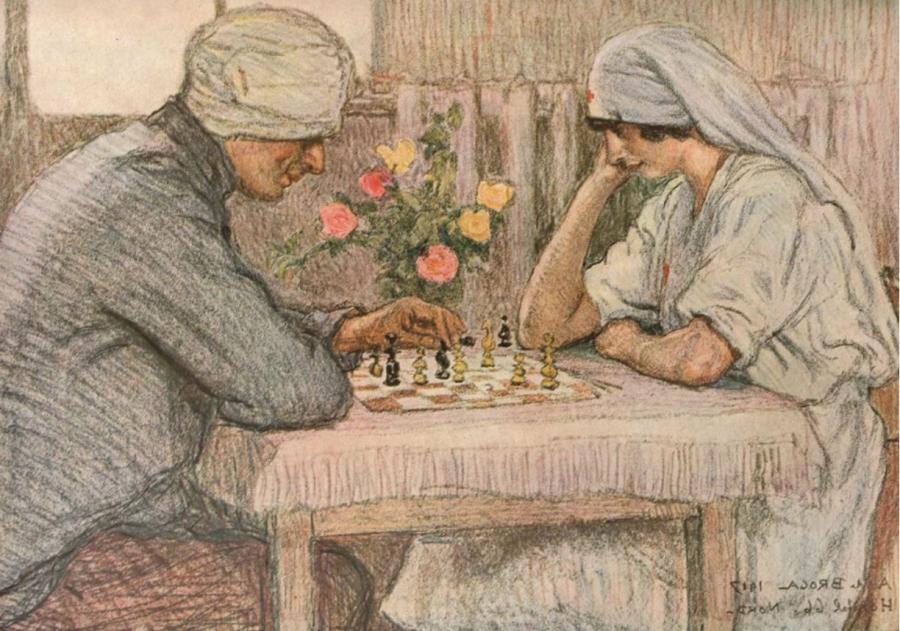The Healers

Alexis de Broca's In the hospital: the chess game.
Gladys Beryl Churchill was just 22 when she volunteered for the Red Cross in 1914. After changing bandages on wounded soldiers when their sheets were moist with blood, she would kneel beside the worst cases, grasping their hands and praying with all her will that they would somehow survive the night. This experience stayed with her all her life, returning as nightmares in which she was back in the ward, helplessly watching men die.
Her story is the inspiration behind The Healers, a pocket opera about women in the First World War, and how they healed men, broken by violence, through love. The Healers is one of a series of works created by the Australian War Memorial’s musical artist in residence Christopher Latham to commemorate the centenary of the First World War.
“We don’t acknowledge post-traumatic stress in women during the First World War, yet I know she suffered from it, as most of them must have. Stoically, they had to face that butchery daily, treating the wounded without flinching,” Latham said.
“Every artist owes someone a debt for recognising their talent when it was only a seed within them, the encouragement often coming at a crucial moment, changing the direction of their life. For me, it came from my English grandmother, Beryl Churchill.
“When on an orchestra tour of the UK after my voice broke, I went to see her, distraught, not knowing what to do with my life. She answered without hesitation, ‘You will become a conductor’. Her confidence in me propelled me forward … and this project gives me the chance to repay my debt and tell her story of service as a nurse on the Western Front.”

Gladys Beryl Churchill, or Granny 'B' as she was known, with her grandson Christopher Latham.
Before the war, Gladys Beryl Churchill – or Granny “B” as the family called her – had been a suffragette, campaigning for the women’s vote. She was studying economics at Newnham College, Cambridge, when war broke out.
“The male students signed up to fight, and were replaced by the wounded as the colleges were transformed into hospitals,” Latham said. “Studying in this sea of patients, my grandmother and her fellow suffragettes volunteered en masse to become members of the Red Cross’ Voluntary Aid Detachment, or VADs.”
They were first trained as orderlies, to clean, deal with bedpans, and wash patients, but given the scale of the carnage, they quickly learnt on the job.
Latham grew up hearing about his grandmother’s experiences during the war, working alongside nurses on the night shift at the all-female Scottish Women’s Hospital, which was staffed by the first female medical graduates from Edinburgh. The Scottish Women’s Hospital at the Abbaye de Royaumont, south of the Somme, treated more than 10,000 patients between 1915 and 1919.
“During those agonisingly long nights for the wounded, a woman’s touch and gentleness was often the most potent of medicines,” Latham said.
“From reading the letters my grandmother received from her patients (addressed to Little Miss Suffragette), it was clear that they loved her, and she, them. Her love, and the love of so many young nurses, helped the wounded to recover.
“The opera portrays the act of healing, showing how these young women brought their patients back from the brink.”
Starring Simone Riksman and Andrew Goodwin, and featuring works by composers who served in the medical services or by soldiers who were wounded or killed, The Healers will be performed in Canberra at the High Court of Australia on 10 October; in Poperinge, the hospital town next to Ypres in Belgium on 19 October; at the Australian Embassy in Paris on 23 October; and in Hirson, France, on the site of a First World War German hospital, on 21 October.
“The Healers is a thank you to my grandmother,” Latham said. “I have a strong sense she will be watching over me as I conduct the Orchestre de Picardie in the concerts in France and Belgium while wearing her Red Cross armband.”
The Healers will be performed in Canberra at the High Court of Australia on 10 October 2017. www.theflowersofwar.org